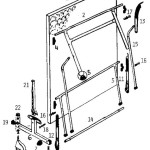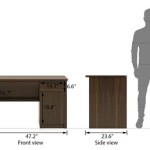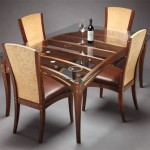Understanding Bar Table Stool Height: A Guide to Choosing the Right Seating
Bar stools are a staple in modern kitchens, dining areas, and entertainment spaces. They offer a stylish and functional seating option that elevates the ambiance of any room. However, choosing the right bar stool height is crucial for ensuring comfort and functionality. The ideal height of a bar stool should complement the height of your bar table, creating a harmonious balance for both dining and socializing.
The Importance of Bar Stool Height
Bar stool height is paramount for achieving a comfortable and ergonomic seating experience. If the stool is too high, it can strain your back, neck, and legs, making it difficult to relax and enjoy your time at the bar. Conversely, a stool that is too low can lead to discomfort and awkward posture. The right bar stool height ensures that your feet can rest comfortably on the floor, with your knees slightly bent, allowing for optimal comfort and support.
Standard Bar Table and Stool Heights
Standard bar table heights generally range from 36 to 42 inches, while standard bar stool heights vary accordingly to ensure proper ergonomics. To determine the appropriate bar stool height, consider the following guidelines:
- Standard Bar Table Height (36 inches): Pair with a 24-inch bar stool.
- Counter Height (34 inches): Pair with a 26-inch bar stool.
- Standard Bar Table Height (42 inches): Pair with a 30-inch bar stool.
Factors to Consider When Choosing Bar Stool Height
While standard bar table and stool heights provide a good starting point, several factors can influence the optimal bar stool height for your specific needs. These include:
1. Bar Table Height
The height of your bar table is the most crucial factor determining the appropriate bar stool height. Measure the height of your table accurately to ensure that the stool height complements it, allowing for comfortable seating and appropriate legroom.
2. Personal Height and Comfort
The height of individuals using the bar stools can impact their comfort levels. If you are taller than average, you may prefer a taller stool, while shorter individuals may find a lower stool more comfortable. Consider the average height of individuals who will be using the stools to determine the most suitable height range.
3. Countertop Material
The material of your bar table or countertop can also influence the optimal stool height. For example, if your countertop is made of granite or other hard materials, you may want to choose a slightly lower bar stool to avoid hitting your knees.
4. Bar Stool Style
Different bar stool styles have different seat heights. Consider the overall design and functionality of the bar stool when choosing the height. For example, a bar stool with a backrest may have a slightly higher seat height than a backless stool.
5. Intended Use
The intended use of the bar stools can also factor into your height selection. If the stools are primarily for casual dining, a lower height may be comfortable. However, if they are intended for extended periods of sitting, such as for working at a bar-height desk, you may want to choose a taller stool with ergonomic features.
Choosing the right bar stool height is crucial for both comfort and functionality. By considering the factors discussed above, you can ensure that your bar stools perfectly complement your bar table and create a stylish and comfortable seating experience for all.
Stool Heights Dimensions Drawings Com

In The Know Stool Height Guide Bar Vs Inside Out Contracts

In The Know Stool Height Guide Bar Vs Inside Out Contracts

Counter Stools Vs Bar Guide Measurement Chart

Redress

Counter Stools Vs Bar Guide Measurement Chart

Bar Stool Size Guide What Height And Width Should My Be Lakeland Furniture Blog

Syngar 5 Piece Bar Table Set Kitchen Counter Height With 4 Stools Space Saving Pub For Person Metal Frame Wood Dining Chair Breakfast

How To Choose A Bar Stool Harrows

Pairing Stool Heights With Bench Nomi








